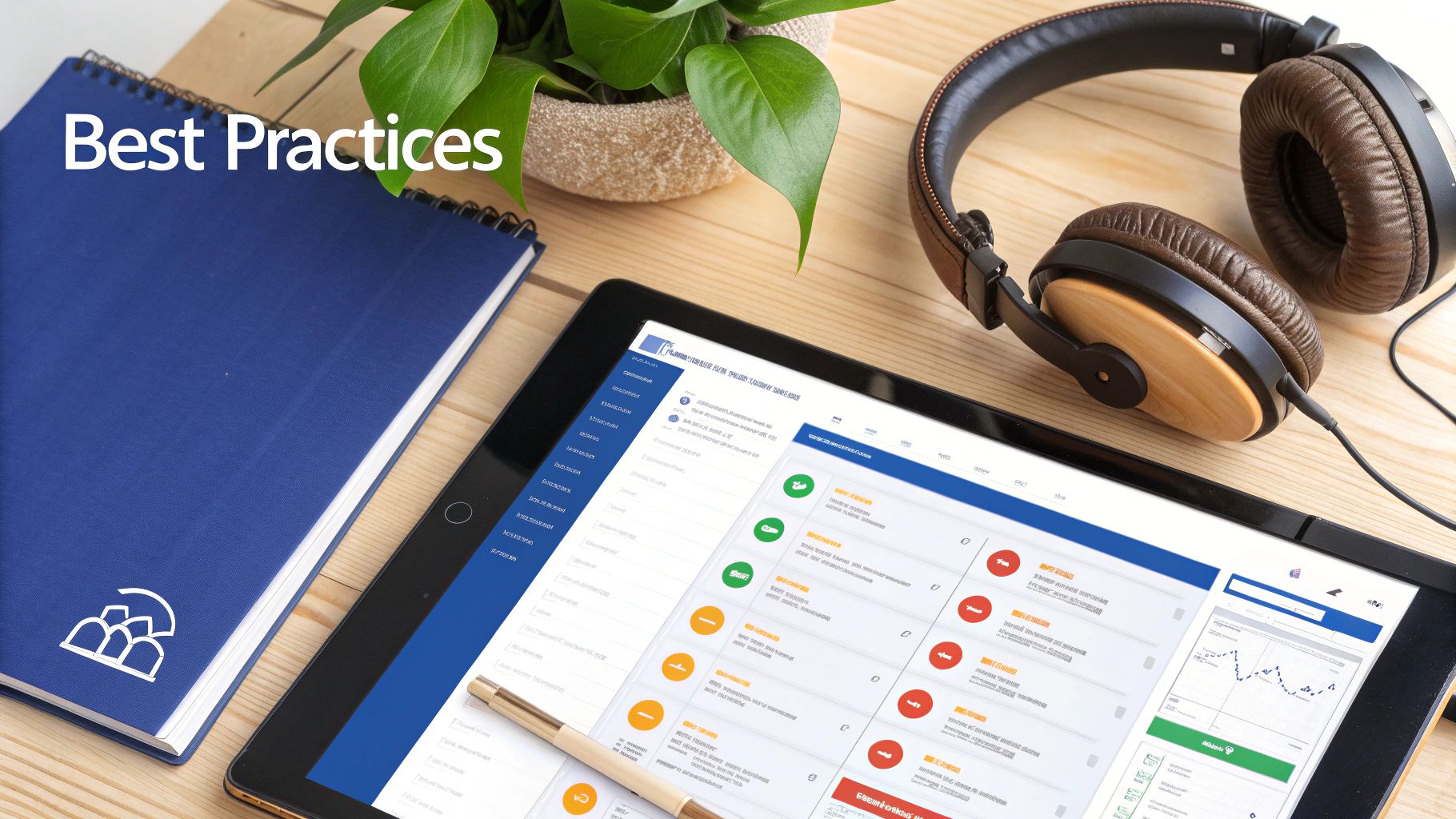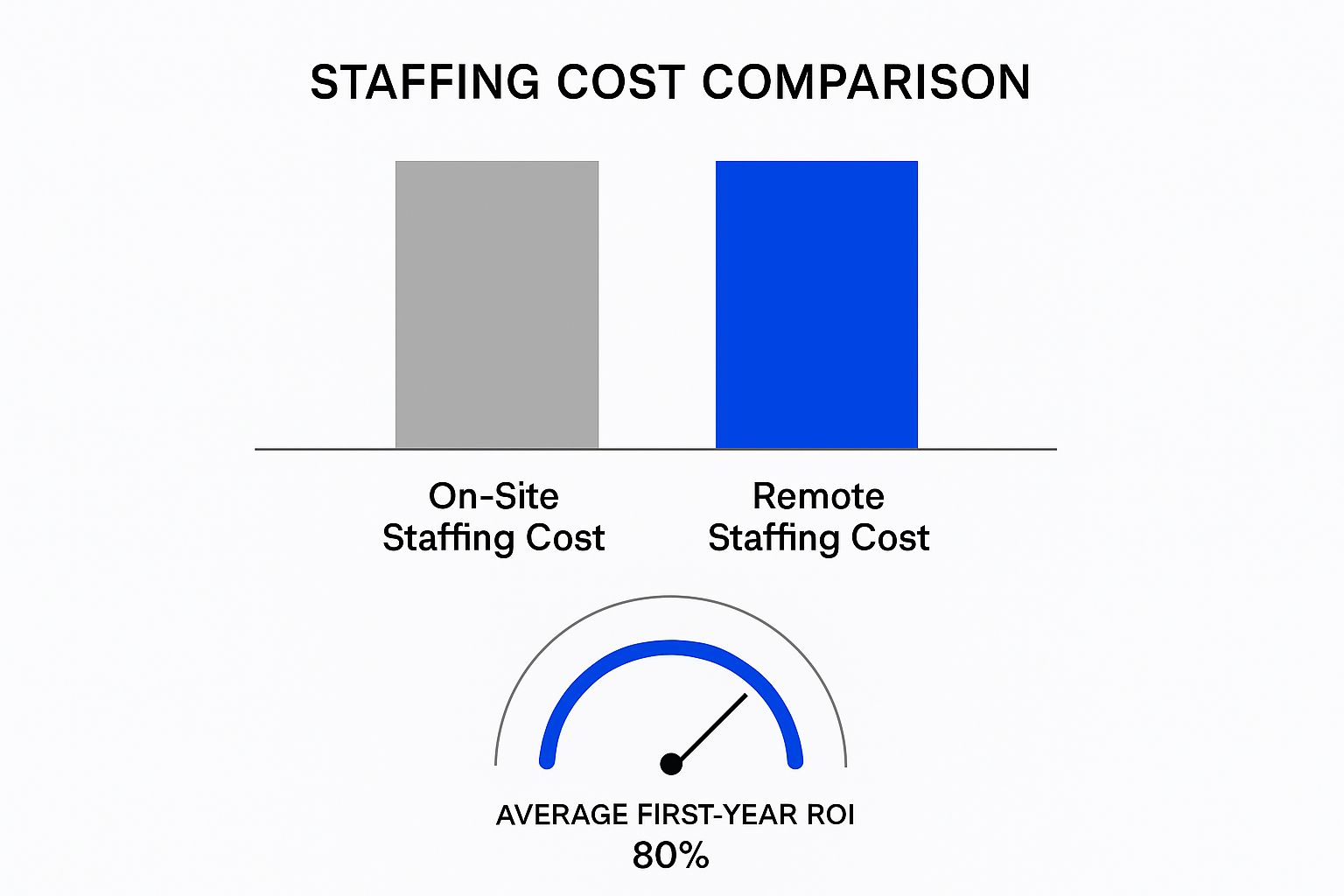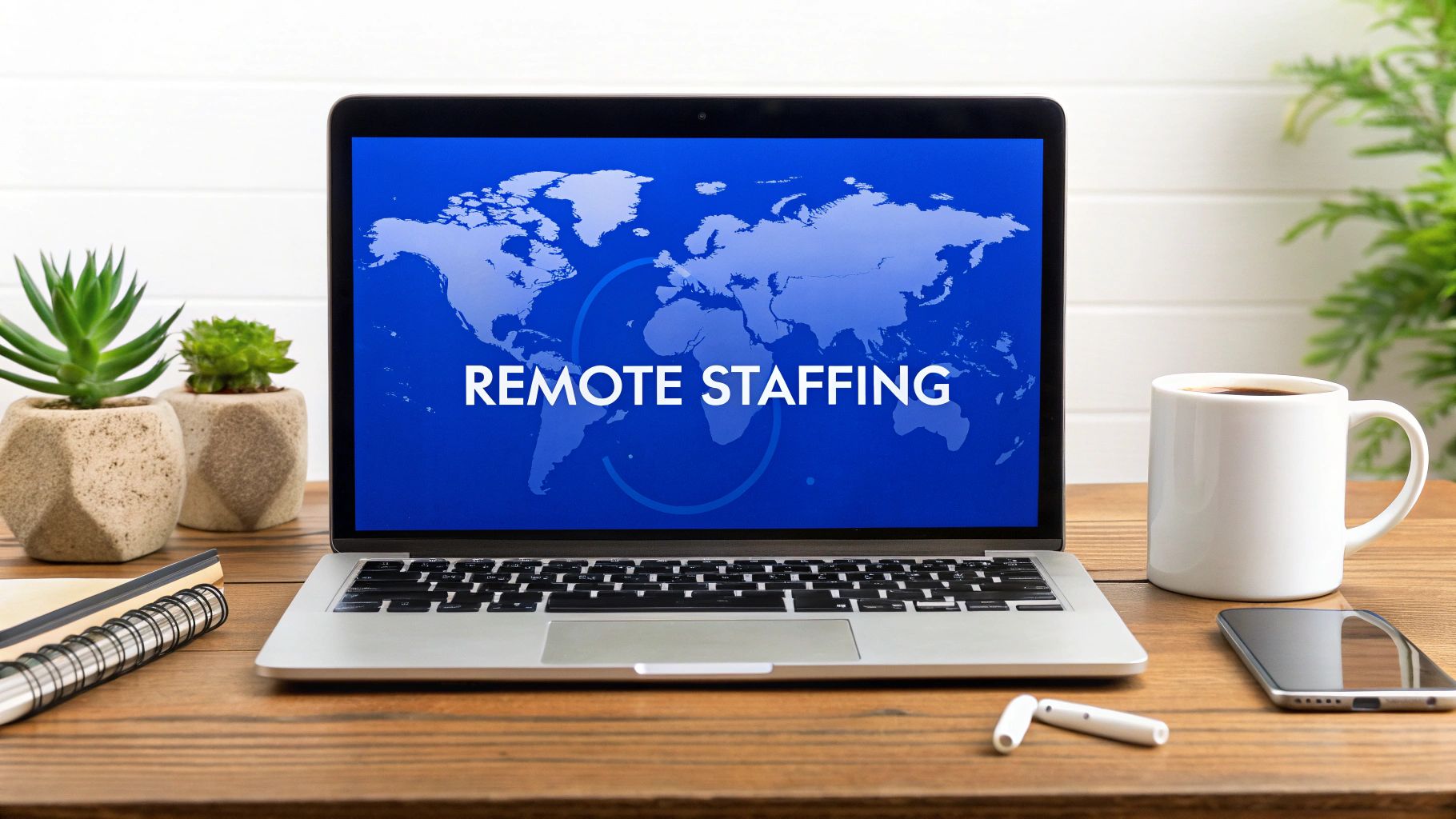Remote staffing is less of a buzzword and more of a fundamental shift in how modern businesses are built. Put simply, it’s a strategy where you hire the best person for the job, regardless of where they live. Instead of being restricted to the talent pool in your immediate vicinity, you suddenly have access to skilled professionals from across the country, or even the world.
This isn't just about convenience; it's about building a team that's more diverse, resilient, and ultimately, more competitive.
The New Blueprint for Business Growth

What many businesses first adopted as a temporary fix has quickly become a cornerstone of long-term strategy. The old idea of a team being defined by the four walls of an office is gone. Today, savvy companies are using remote staffing solutions to pinpoint the perfect fit for a role, whether that person is in the next town over or on another continent.
This is a much bigger deal than just letting staff work from home a few days a week. It's about deliberately designing your entire workforce to be distributed, agile, and ready for whatever comes next. The numbers back this up, showing a permanent change in the UK's working culture, not just a passing phase.
A Look at the Numbers
Remote work is now deeply woven into the fabric of the UK economy. An incredible 40% of UK workers are now involved in some form of remote work. That figure breaks down into 14% working entirely from home and another 26% splitting their time in a hybrid model.
To put that into perspective, back in 1981, a mere 1.5% of the workforce operated remotely. You can explore this workforce evolution to see just how significant this change has been for UK businesses.
This move is fuelled by a growing appreciation of the tangible benefits. Businesses are quickly realising that a global talent pool isn't just a nice-to-have—it's a genuine competitive advantage.
By looking beyond local candidates, companies can tap into specialised skills, increase team diversity, and build a more robust operational structure that isn't dependent on a single physical location.
The Three Core Models of Remote Staffing
To get remote staffing right, it’s crucial to know the different ways you can build your team. Each approach has its own strengths, so you can pick the one that aligns with your specific goals.
To make this clearer, let's break down the main ways businesses are approaching remote hiring.
Quick Guide to Remote Staffing Models
Understanding these different avenues is the first, most important step towards building a remote team that truly performs. Each model offers a different level of control, cost, and commitment, allowing you to create a flexible and powerful workforce.
Why Top Companies Are Choosing Remote Staffing

It’s one thing to know the different ways remote work can be structured, but the real question is why so many successful companies are making this move. It’s not about following a trend. The shift is rooted in powerful, real-world business advantages that fuel growth, boost efficiency, and build a more resilient organisation.
Smart companies aren't just dabbling in remote staffing solutions anymore; they're weaving them into the very fabric of their business strategy. The biggest driver? Access to a global talent pool. When you’re no longer limited by location, you can hire the absolute best person for the job, not just the best person who happens to live within a 30-mile radius of your office.
The Strategic Edge in Practice
Let’s imagine a fintech startup in London needs a developer with a very specific, niche skill set. Instead of fighting for the few expensive local experts, they can hire a world-class developer from another city or even another country. This often comes at a more sensible cost and completely sidesteps the headache and expense of relocation.
This kind of strategic thinking unlocks some serious benefits:
Drastic Cost Savings: The most obvious win is cutting down on overheads. With less need for huge office spaces, you slash costs on rent, utilities, and all the associated office management expenses. That money can be poured back into what really matters—innovation, growth, or developing your team.
Happier, More Productive People: When you give people the freedom to work where they feel most focused and comfortable, productivity naturally climbs. This autonomy is a huge morale booster, which in turn helps you keep your best people and attract new talent in a competitive market.
A More Agile, Resilient Business: A distributed team is simply stronger. It's less exposed to local problems, whether that’s a transport strike, a regional power outage, or an economic downturn. This agility means you can keep things running smoothly, no matter what’s happening on the ground.
Flexibility isn't a perk anymore; it's a core expectation of the modern workforce. Companies that fail to recognise this are at serious risk of losing their top talent to competitors who get it.
Meeting Modern Workforce Demands
This change isn't just coming from the top down; it's a direct response to what employees want. The desire for remote work is a powerful force in the UK labour market. Right now, 43% of the workforce is already in a hybrid or fully remote role.
What’s more, a massive 58% of workers say remote options are 'important' or 'very important' when looking for a new job. For any leader trying to build effective remote hiring strategies, ignoring these numbers is a mistake. In fact, research shows that more than two-thirds of UK workers would think about quitting if forced back to the office full-time.
By getting on board with remote staffing, companies are doing more than just saving money. They are building stronger, more talented, and more motivated teams ready for whatever comes next.
Key Considerations for Your Remote Workforce

Building a high-performing remote team isn't something that just happens. It takes a deliberate and thoughtful approach. Before you even think about hiring, you need to lay the groundwork. This means getting serious about how your team will communicate, the tools they'll need, and how you’ll knit together a strong culture when everyone's miles apart.
Successfully putting remote staffing solutions into practice really comes down to getting these fundamentals right from the very beginning. When you have a solid framework in place, what could have been major headaches become simple, manageable tasks. By thinking through these key areas now, you’re paving the way for a smooth transition and setting your remote team up for success.
Establish Crystal-Clear Communication Protocols
When your team isn't in the same room, you can't leave communication to chance. Those spontaneous chats by the water cooler or quick desk-side questions are gone. This means you have to be intentional about how information flows.
Decide on your channels and stick to them. For example, maybe an instant messaging tool like Slack is perfect for quick, urgent questions. For more formal updates that need a paper trail, email is your best bet. Meanwhile, a project management platform like Asana or Trello should be the undisputed source of truth for who's doing what, which cuts out the guesswork and endless check-ins.
The real aim here is to build a communication ecosystem where everyone knows exactly where to look for information and how to reach out, no matter their time zone. This clarity removes friction and gives people the autonomy they need to get on with their work.
Invest in the Right Technology Stack
Think of your technology stack as the digital headquarters for your remote team. Giving them the right tools isn't a "nice-to-have"; it's essential for keeping everyone productive and connected. This goes far beyond just having video conferencing software. It's about creating a seamless and efficient virtual workspace.
A solid tech stack usually covers a few key areas:
- Collaboration Hubs: Tools like Slack or Microsoft Teams act as the central nervous system for daily chats and team interactions.
- Project Management Software: Platforms such as Asana, Trello, or Jira provide a transparent view of tasks, deadlines, and project progress.
- Cloud Storage and Documentation: Services like Google Drive or Notion make sure everyone is working from the latest version of important files and documents.
Nurture a Unified Company Culture
Keeping a strong company culture alive can feel like a tall order when your team is spread out. But honestly, it's one of the most important ingredients for long-term success with remote work. Culture doesn't just happen; it's built through shared experiences, lived values, and deliberate efforts to connect.
You have to be proactive about creating spaces for social interaction. Set up virtual coffee breaks, plan some online team-building games, or create a non-work chat channel where people can share hobbies and life updates. Most importantly, make sure you celebrate wins and give praise publicly. It reinforces your company values and makes every single person feel seen and valued, no matter where they log in from.
Choosing the Right Remote Staffing Model
Picking the right way to build your remote team is a big decision, and honestly, there's no one-size-fits-all answer. The best approach for your business hinges entirely on what you're trying to achieve, your project timelines, and how much hands-on control you want to maintain. Getting this right means your staffing strategy will actually support your bigger business goals.
This is why it’s so important to get your head around the different remote staffing solutions out there. Are you after a specialist for a quick, one-off job? Or are you looking to build a fully integrated global team for the long haul? Each of these scenarios needs a completely different playbook.
Independent Contractors and Freelancers
Hiring independent contractors or freelancers is by far the most flexible and nimble option. Think of it like calling in a specialist plumber or electrician for a specific repair. You bring in a skilled expert for a clearly defined task, and once the work is done, you both go your separate ways.
This model works brilliantly for:
- Short-term projects with a clear beginning and end.
- Tapping into highly specialised skills that you don't need full-time.
- Staying agile by scaling your team up or down based on demand.
The trade-off, of course, is that this flexibility means less integration. Contractors are external partners, not really part of your core team, which can make it tough to build a unified company culture. This is an increasingly familiar setup, especially as remote work reshapes UK employment. In fact, nearly half (44%) of the UK's workforce now works from home at least some of the time, and contractors often have even more freedom than permanent staff. You can read more about these remote working trends in the UK to get a better sense of the landscape.
Business Process Outsourcing (BPO)
Working with a Business Process Outsourcing (BPO) company is a totally different ball game. You’re not just hiring individuals; you’re handing over an entire business function—like your customer support desk, IT helpdesk, or accounts department. The BPO firm takes care of managing the team, the processes, and all the underlying infrastructure for you.
This can be a fantastic move when you want to delegate a function that's essential but not core to what you do, freeing up your in-house team to focus on innovation and growth. The catch? You give up direct, day-to-day control over that team and how they operate.
Employer of Record (EOR)
For businesses that want to hire globally without getting tangled in a web of international legal and admin headaches, an Employer of Record (EOR) is the perfect middle ground. An EOR acts as the official, legal employer for your remote staff in their home country. They handle all the tricky stuff—payroll, taxes, benefits, and local compliance—on your behalf.
An EOR lets you hire and manage top talent anywhere in the world as if they were your own direct employees, but without the cost and complexity of setting up a local legal entity. It’s the gold standard for compliant, long-term international team building.
This model gives you the direct management relationship you'd have with a traditional employee, combined with the global reach of remote work. It really is the best of both worlds, though it does come with partnership costs. If you're serious about building a dedicated, long-term remote team, checking out the top remote recruitment agencies that specialise in these models is a logical next step.
Comparing Remote Staffing Models
To help you visualise how these options stack up, here’s a quick side-by-side comparison. Each model has its own strengths, so think about which features align best with your company's immediate and future needs.
Ultimately, the right choice comes down to balancing control, cost, and complexity. An EOR often provides the most balanced approach for strategic, long-term growth, while freelancers offer unparalleled agility for specific, short-term needs.
The infographic below highlights how these solutions can deliver impressive cost savings and a strong return on your investment. As you can see, the financial upsides from reduced overheads and access to a global talent pool make remote staffing an incredibly powerful strategy for any company looking to grow.
As you can see, the financial upsides from reduced overheads and access to a global talent pool make remote staffing an incredibly powerful strategy for any company looking to grow.
Best Practices for Managing a Remote Team
Bringing talented remote professionals on board is just the first chapter. The real story begins when you start leading them. To do it well, you have to let go of old office-based habits and adopt a completely different mindset—one built on deliberate clarity, trust, and connection. This is how you create a team that doesn't just perform but genuinely thrives.
The most critical shift? Stop watching the clock. Forget about measuring hours worked. The only thing that truly matters is measuring outcomes and impact. This creates a culture of autonomy and accountability, where your team feels empowered to manage their own time, knowing that what counts is the quality of their results. It's the secret to getting the most out of your remote staff.
Set Unambiguous Goals and Expectations
In a remote setup, ambiguity is the enemy. If people aren't crystal clear on what they need to do, why it matters, and how their work fits into the bigger picture, confusion and disengagement are right around the corner.
To keep everyone aligned and motivated, you need to:
- Establish Clear Key Performance Indicators (KPIs): Make sure every role has specific, measurable targets. Everyone should know exactly what a "win" looks like for them.
- Document Everything: Create a single source of truth—a central, easy-to-access hub for project briefs, company processes, and policies. This empowers people to find their own answers and cuts down on repetitive questions.
- Hold Regular, Structured Check-ins: Schedule consistent one-to-ones and team meetings that are focused on progress and problem-solving, not just listing off what you did that week.
Foster Asynchronous Communication and Trust
For remote work to be sustainable, you absolutely must get good at asynchronous communication. This simply means building a system where work can keep moving forward even if everyone isn't online at the same time. It’s a way of respecting different time zones and personal schedules, promoting deep, focused work instead of constant interruptions.
Trust is the currency of a remote team. It’s built by giving your people the autonomy to work how they best see fit, while providing the support and resources they need to succeed. Micromanagement signals a lack of trust and is a swift route to team burnout and low morale.
When you show your team you trust them to deliver, you ignite a powerful sense of ownership and responsibility that naturally drives high performance. This principle is a cornerstone of many essential remote team management tips and is fundamental to long-term success.
Run Productive and Engaging Virtual Meetings
Let's be honest, virtual meetings can be a huge drain. To make them worthwhile, every single one needs a clear purpose, a tight agenda, and someone in charge of keeping things on track. Keep them short, focused, and only invite the people who genuinely need to be there.
And don't forget to celebrate! Make a point of shouting out wins publicly, whether it's in a dedicated Slack channel or at the start of a team meeting. Recognising hard work is crucial for morale, especially when you can't offer a high-five in the hallway. By building this kind of positive, supportive atmosphere, you'll unlock the full benefits of remote workers and cultivate a team that’s both loyal and deeply motivated.
Right, let's get those common questions about remote staffing sorted. When you're thinking about bringing remote team members on board, it’s completely normal to have a few things you're not sure about. This section is all about tackling those head-on, giving you straight, practical answers so you can move forward with confidence. We'll get into the real-world stuff and clear up any confusion.
How Do I Know My Remote Team Is Actually Working?
This is probably the biggest question on every leader's mind. The trick is to stop thinking about watching the clock and start focusing on results. In an office, it's all too easy to see someone looking busy and assume they're being productive. When your team is remote, you have to be much clearer about what success actually looks like for their role.
It all comes down to setting clear Key Performance Indicators (KPIs) and using straightforward project management tools, like Trello or Asana, to see how work is progressing against those targets. Forget about micromanaging from afar; regular, structured check-ins are infinitely more effective.
The best remote teams are built on a foundation of trust. Give your people the autonomy to manage their own schedules and work when they feel most focused, as long as the results are high-quality and on time. Solid, clear documentation of your processes is also a must—it gives people the tools they need to work independently and be fully accountable.
At the end of the day, productivity isn't about the hours someone puts in; it’s about the value they create. When you hand over that trust, you’ll often find your team feels a greater sense of ownership and, in return, delivers their absolute best work.
Won't We Lose Our Company Culture?
This is a very real challenge. You can't just hope for a great culture to happen by accident. In an office, those spontaneous chats by the coffee machine or in the hallway build connections naturally. Remotely, you have to be deliberate about creating those moments.
Building a strong remote culture means actively making space for people to connect on a human level, beyond just talking about work.
- Host Virtual Socials: Get some regular online coffee breaks, team-building games, or even a virtual 'happy hour' in the diary. It helps your team see each other as people, not just colleagues.
- Open Up Non-Work Channels: On your communication platform, like Slack or Microsoft Teams, create dedicated channels for hobbies, random chat, or sharing photos and personal news.
- Live Your Values: A strong culture is really about a shared purpose. Make your company values crystal clear from day one and celebrate them. Publicly recognise people who embody the behaviours you want to see.
It takes effort, but by being intentional, you can build a vibrant, supportive culture that genuinely connects people across any distance.
Is Remote Staffing Really Cheaper?
For the vast majority of businesses, yes, it absolutely is. The biggest saving is the most obvious one: overheads. Just think about all the costs tied to a physical office space—rent, utilities, furniture, cleaning, supplies. All of those either disappear or shrink dramatically.
On top of that, you suddenly have access to a global talent pool. This means you can find incredible professionals in regions where the cost of living isn't as high, letting you sidestep the inflated salaries common in big city tech hubs. In fact, some studies show businesses can slash their overheads by as much as 40% by staffing strategically offshore.
Of course, you do need to budget for a new set of costs. These will likely include things like:
- Home office stipends for equipment.
- Subscriptions to collaboration and communication software.
- Potential travel budgets for getting the team together for in-person events once or twice a year.
But even when you factor in these new investments, the huge savings on property and talent nearly always result in a major financial win. It makes remote staffing a smart, sustainable way to grow your business.

